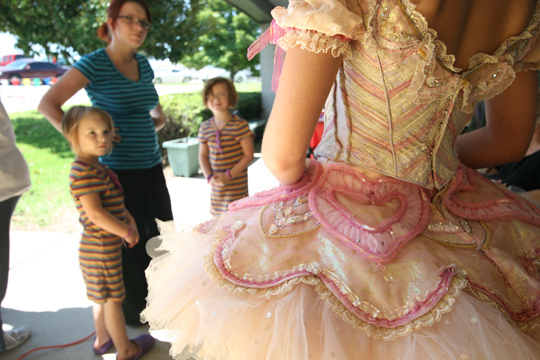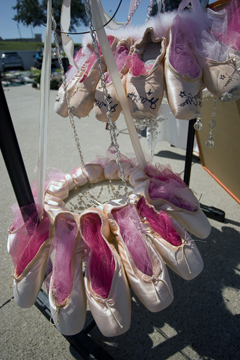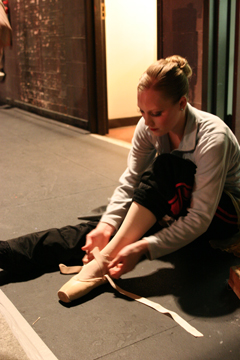 Little girls’ ballerina dreams come true as they line up to pose with a dancer for $20 a shot. Naomi Vaughan
Little girls’ ballerina dreams come true as they line up to pose with a dancer for $20 a shot. Naomi Vaughan
|
 The dancers autographed their scuffed old pointe shoes and sold them to raise funds. Naomi Vaughan
The dancers autographed their scuffed old pointe shoes and sold them to raise funds. Naomi Vaughan
|
 A TBT dancer solicits donations from drivers near the company’s offices. Naomi Vaughan
A TBT dancer solicits donations from drivers near the company’s offices. Naomi Vaughan
|
 Dancer Jayme Autrey Griffith prepares for last week’s TBT season opener in Dallas. Naomi Vaughan
Dancer Jayme Autrey Griffith prepares for last week’s TBT season opener in Dallas. Naomi Vaughan
|
|
A D V E R T I S E M E N T
|
|
|
|
A D V E R T I S E M E N T
|
|
Tipping Pointe
Dancers and directors put blood, sweat, and tutus into Texas Ballet Theater’s survival.
By JIMMY FOWLER AND LEONARD EUREKA
The Saturday afternoon was hot and windy, and the charity folks working the vehicular crowd at the intersection of I-30 and Green Oaks Road were young men and women in white and red t-shirts and shorts, who waved signs, shouted friendly encouragements, and took cash donations through rolled-down car windows.
These street-corner solicitors were not promoting, say, a car wash to benefit some church youth program. If you lingered long enough, you’d notice that the fund-raisers — all of them thin, toned, and muscular — would occasionally spin in place or balance on one foot, the other leg held aloft at a perfect right angle.
In the parking lot behind them, lines of multicolored flags roped off a small benefit sale featuring used and new items. Shoppers idly perused the clothing, computers, glassware, and artwork, furniture, and other items on display.
There were tell-tale signs that this was not your average fund-raiser. Items up for sale included an autographed portrait of Elizabeth Taylor and a limited edition “Fantasy Goddess of Asia” Barbie doll with diaphanous gold dress designed and signed by Bob Mackie. Clusters of scuffed pointe shoes, autographed and stuffed with bright pink material, were on sale. Tucked away in a shady corner, a young female ballet dancer in puffy tutu was posing for $20 photos with excited little girls, who’d formed a short line with their parents. Canvas blow-up recreations of Roman art were stretched on the pavement, remnants of a recent fund-raising performance at Meacham Field. Meanwhile, the score from Delibes’ comic ballet Coppelia swelled vivaciously out of the speakers.
The parking-lot sale was an unusual event for one of North Texas’ most critically acclaimed arts institutions, the Texas Ballet Theater. For an organization of its caliber and quality, you typically imagine high-dollar champagne receptions with the city’s top philanthropists followed by exclusive performance previews of the season. Instead, on that sweltering Saturday afternoon in the parking lot of the Texas Ballet Theater School (TBT’s private academy for aspiring young performers), most of the company’s 38 dancers were moving antique furniture into the beds of pickup trucks, counting wrinkled dollar bills in little tin boxes, and hobnobbing with bargain shoppers, many of whom had probably never seen a ballet performance.
Tough times call for such out-of-the-box tactics. Depending on whom you talk to, the 48-year-old ballet group is either facing imminent death or simply weathering the kind of economic storm that periodically afflicts many nonprofit arts groups. At a recent meeting of the theater’s board, the original Sept. 10 “do or die” deadline to raise $2 million — including half a million in cash to pay creditors like Bass Hall and the Fort Worth Symphony Orchestra — had been moved to mid-October, closer to the tentatively scheduled Oct. 17-19 performances of Mozart’s Requiem, to open the troupe’s 2008-2009 season. As the contributions come in fits and starts, so do the deadlines.
While high-dollar donations are being sought from philanthropists in genteel behind-the-scenes begging sessions, the dancers aren’t sitting idly by tapping their toes and polishing their codpieces. They’ve literally taken to the streets, searching out cash contributions in every way they can imagine, to keep the company alive. In the process, they’ve added countless hours of unexpected labor to their already exhausting lives as performers. As Justin Urso, a five-year dancer with the company, said with a weary laugh: “If people think a ballet dancer’s life is just ‘rehearse and perform, rehearse and perform,’ give them my number. I can tell them how it is.”
If you need an explanation for the dancers’ passionate launch of their own impromptu fund-raising campaign, look no further than the genial man in the enormous straw hat who presided at a folding table at that recent parking lot sale, part of the “Get Behind Your Ballet” effort launched by the dancers. He is Ben Stevenson, the troupe’s artistic director since 2003.
“I’m a 72-year-old former dancer with a 72-inch waist,” he said wryly. “The real artists are the ones working to keep this company afloat, spending every waking moment to rehearse, perform, and raise money. It’s beyond the call of duty, but they’re doing it.”
The British-born Stevenson represents the high point in the creative trajectory achieved by the formerly named Fort Worth Ballet, founded as a modest civic company in 1961. A quarter-century later, Paul Mejia, who had studied under New York City Ballet’s iconic master George Balanchine, came aboard as artistic director and took the company on an acclaimed, Balanchine-fueled tour across the country. In 1996, Fort Worth Ballet changed its name to Fort Worth Dallas Ballet after benefactors lured the troupe into performing full seasons at Dallas’ Fair Park Music Hall.
They renamed themselves again, as Texas Ballet Theater, after Stevenson became artistic director in 2003. World-renowned as the “king of storybook ballet” for his sweeping original dance narratives, he has worked with the great ballet companies of England, France, Italy, Germany, and Canada. Stevenson moved stateside and took the artistic wheel of the National Ballet in Washington, D.C., and, in 1976, the Houston Ballet. He almost single-handedly raised the artistic profile of the Houston Ballet to international prominence with world premiere works, both by Stevenson and commissioned artists.
After nearly 27 years in Houston, Stevenson was prepared to retire covered in lush plaudits — Queen Elizabeth named him an Officer of the Order of the British Empire in 1999 — before he got the offer in 2002 to helm the North Texas ballet organization. He relished the thought of developing another small company into a major regional operation; it would be his last service to dance before he officially retired. Multiple members of the Houston Ballet, as well as students at its Ben Stevenson Academy, promptly followed their master to Fort Worth. They include Urso, now a corps dancer in the TBT ensemble who’s enjoyed featured roles in Stevenson’s versions of Dracula and Coppelia.
The 26-year-old Urso struggled for just the right words to express his deep respect for Stevenson. “He’s famous, of course, for using dance to tell a story and not just an excuse for dance,” he said. “But he makes his dancers an important part of that story. Plus, he’s hilarious. You find yourself laughing while you work, and it makes you want to work harder.”
Robin Bangert, another corps TBT dancer who relocated to Fort Worth because of her work with Stevenson at the Houston Ballet, agreed. Under the choreographer’s direction, she has danced as Clara in The Nutcracker and as a cygnet in Swan Lake. “He can be tough on us, for sure,” the 23 year-old said. “But he’s full of stories about the ballet world. He says that ballet is one art form that’s united all over the world. That makes the dancers feel important. Even if you’ve got some little part in a pageant country scene, he makes you feel like you’re a big part of that show.”
Most of TBT’s dancers share similarly reverent attitudes toward their artistic director. Those feelings were put to a test in early August, when they found themselves faced with the real possibility that their tutelage under Stevenson would meet a sudden end.
It’s been a wild few weeks since then, as the troupe and its supporters continue to wrestle with the financial crisis that threatens to pull it apart. A breakdown in communication between the company’s administrative wing and its board of directors had resulted in an accumulation of debts that swamped the operation.
According to TBT interim managing director Margo McCann, one of the biggest reasons for the financial crisis is that the company has been without a development director for three years. In lieu of filling that post, the senior board hired separate fund-raisers for each city, with no oversight to keep left hand and right hand coordinated. The development director would have done that, McCann said. “He or she is the point person who keeps their eyes on the cash flow and keeps the lines of communication [about money] open.”
Another issue was that TBT unexpectedly lost a $1 million gift it had been receiving annually for several years — from a private donor who asked to remain anonymous, for reasons McCann would not explain. “It should’ve been stressed that private donations are gifts that can’t be relied upon from year to year,” McCann said. The simplest way to explain the company’s current troubles, she said, is that “we became complacent.” McCann stressed that the oversight problem has been fixed.
But a bright side has emerged as TBT goes about righting the ship. The groundswell of support that rose up when the company’s troubles came to light may have surprised even the ballet organizers, and it has brought in well over $1 million thus far, enough to allow the season-opening program at Dallas’ Majestic Theatre to go ahead last week. Only one of three scheduled performances was offered, but that was one more than was expected just a short time ago. The company still needs another $1 million by year’s end.
Hundreds of small contributions have come in, including a $200 gift from Kevin Pope, a U.S. Army soldier stationed in Baghdad, who heard from his wife that the company was hurting and sent what he could to help out. The couple regularly attends TBT performances when he’s home. Nine-year-old Claire Mildren, a TBT dance school student, canvassed her neighborhood collecting donations and set up a lemonade stand in her front yard, charging $1 a glass. Claire raised $3,000 herself, propelled by her own dreams of becoming a dancer.
On a grander scale, a week after TBT announced it would have to cut the Fort Worth Symphony and switch to taped music for performances, the local Garvey Texas Foundation came up with $47,000 to underwrite the orchestra’s appearance at Bass Performance Hall in October. That program will include the Fort Worth premiere of Stevenson’s powerful setting of the Mozart Requiem. The ballet was seen in Dallas last season at the Majestic Theater using taped accompaniment and blew most of the audience away. That theater’s pit is too small for a full orchestra, and the stage too small to provide room for a chorus, but the effect was still magical. By Tuesday, however, funding for the Bass Hall performance still was not 100 percent guaranteed. Things are that close in the money department.
Perhaps the most heroic effort has come from the dancers themselves, who have raised more than $180,000 in three weeks. In the “Get Behind Your Ballet” campaign, they’ve fanned out across the city going door to door asking for contributions, as well as dancing mini-programs at the Galleria in Dallas and the Museum of Modern Art here to raise awareness of their plight. After appearing at the museum, many of them were at the company studios in Ridgmar Mall at 5:30 the next morning for that big parking lot sale, which brought in $18,000. WRR-FM 101.1 broadcast a recent two-hour Sunday program from Barnes & Noble bookstore in Southlake, for which the store donated part of the day’s proceeds.
“Unfortunately, our dancers are not highly compensated [by their dance paychecks],” said Stevenson. “Most of them work at other jobs. It’s a hard life, and it’s a short career. Even if you don’t seriously injure yourself and your body lasts, you’re very lucky to extend a career to the age of 40.”
The short-lived, high-stress, low-paying nature of a professional dance career is pretty much a given. But when these artists signed up to perform Stevenson’s celebrated choreography under the Texas Ballet Theater banner, none could’ve predicted that going door to door in a tutu would be part of the bargain.
Urso and Bangert, along with dancer Mark Troxler, are the co-creators of the grassroots “Get Behind Your Ballet” effort. They are also the company’s “dancer reps” — that is, they act as liaisons between the dancers and administrative staffers and board members. In early August they were informed by the board about the theater’s dire financial straits. As reps, their duty was to inform their fellow dancers. It was a complete blindside.
The multiple debts and low cash reserves came to light when the company was forced to cancel a trip to China. The troupe was scheduled to perform Stevenson’s Cleopatra at a prestigious international festival in Shanghai. TBT’s participation at the festival was heralded back in February at a joint press conference featuring Fort Worth Mayor Mike Moncrief and his Dallas counterpart Tom Leppert.
What prompted the cancellation, said McCann, was that “the Chinese government wouldn’t pay for the shipping of sets and costumes, after it had initially promised to do so.” When the company went to Texas donors to raise money to cover those expenses, the accounting ledgers were opened, and the exact nature of the debts and liquidity issues were revealed. Explanations about who knew and didn’t know or should have known that the company was in such trouble tend to be vague, no matter how the question is phrased. Current TBT administrators are clearly uncomfortable with publicity about money troubles that might impede further fund raising.
Although the scrapped performance in China came as a big blow, a darker and even more unthinkable worry had appeared on the horizon: the question of whether the company could survive at all. Urso, Bangert, and Troxler pow-wowed the night before they told the rest of the company that TBT’s future was precarious. A list was quickly drawn up of possible ways that the performers themselves could raise money: door-knocking in neighborhoods, downtown donation drives, garage sales. Although none of the troupe’s 38 dancers had any fund-raising experience, nobody hesitated. It’s unusual for artists to take to the streets to support their company but not unprecedented.
“We took inspiration from the San Francisco Ballet,” said Bangert, referring to a 1974 street-corner campaign that is legendary in the American ballet world. “They had big money problems, but they raised $2 million from mostly small cash contributions given by people walking down the sidewalk.”
Hoping to make a big splash during one August afternoon, the troupe’s 38 dancers split into two groups and launched donation drives simultaneously in downtown Fort Worth and Dallas. Dancers carefully wove their way through the afternoon traffic outside Bass Hall. In Fort Worth, almost everyone they encountered offered some small contribution. In Dallas, they were less successful: The effort at One Arts Plaza was promptly curtailed by sympathetic police, who had to intervene because the dancers hadn’t obtained the proper city permit. They relocated to the American Airlines Center, smartly positioning themselves outside Belo’s glass-walled WFAA/Channel 8 news studios. A reporter came outside and interviewed them about their plight for a broadcast segment.
“The pink tutu is a perfect hook,” Bangert said with a chuckle, and it proved so again and again as dancers fanned out in a door-to-door campaign in Fort Worth neighborhoods. Urso said they charted a plan of attack using city maps. Eighteen dancers, in male/female pairs, were deployed for two hours each afternoon, which meant on any given afternoon nine streets were being stalked by a money-seeking pas de deux. The women, of course, were wearing the deal-closer — the tutu. The guys kept their garb to a more conservative shorts-and-t-shirt look, fearing that potential donors might be unsettled by a young male stranger in tights on their front porch.
“Ninety-nine percent of the people were great,” said Urso. “As soon as one woman saw the tutu, she pulled out her checkbook before she even invited us in. I think there was a small shock from having ballet dancers at your door asking for money.”
The dancers are defiantly optimistic about the company’s future. The $180,000 they’ve raised by their own sweat is impressive, and it’s being used to buy time to raise more money to secure future performances.
In their personal lives, time is not something the dancers have to burn. Urso and Bangert have to be at the company studios by 8:15 a.m. for classes. They spend the afternoon rehearsing for the tentative upcoming performance, take an early evening break for fund-raising duties, and show up for their night jobs as bartenders at the downtown club Embargo, frequently working as late as 2 a.m.
“You’re either addicted or you’re not,” said Urso. “You do it for that high on stage.”
Bangert said that it’s difficult, both mentally and physically, for artists to prepare for a season that at any moment could be cut back or cancelled. Professional ballet, she said, “is not something that you can just pick up after you’ve had a long break in your schedule. You have to keep working every day so that your body stays tuned up and ready.” Unexpected interruptions don’t affect just company morale; they’re felt in every dancer’s bones and tissue.
And so last Friday, the dancers were back on the boards instead of the pavement, putting aside monetary worries for a few hours to present their season opener in Dallas, an impressive program of smooth ensemble pieces and individual show-stoppers, all danced to recorded music. Reality waited just outside the Majestic Theater, in the form of picketers from the union of Dallas-Fort Worth Professional Musicians. They were protesting the company’s announced plan to present the whole season using taped music, if financially necessary. Inside, a full house cheered itself hoarse by the end of the evening. (See review, page 22.)
With that performance behind them, the dancers are determined to continue their “Get Behind Your Ballet” efforts. This Friday they’re hosting a “Rock the Ballet” fund-raiser at Embargo. Fort Worth musicians Josh Knight, February Chorus, and Telegraph Canyon will perform while TBT dancers give salsa lessons in keeping with the club’s Latin theme. In Dallas, the Mansion on Turtle Creek hosts a tonier Sept. 21 silent auction, where antiques, vacation packages, cars, and spa treatments will be up for high-dollar bids.
For their part, Stevenson and McCann are shaking the trees and collecting all the coins that fall. The artistic director recently convinced a well-heeled friend to give $100,000 in cash as part of a $500,000 pledge to be distributed over a five-year period. And McCann noted that TBT is more than halfway to meeting its goal of $2 million to remain operational for the calendar year. The plan is to stay afloat until they can trot out that reliable December cash cow The Nutcracker, which accounts for 70 percent of their total annual ticket revenue.
The bitter irony is that “artistically, we’re more successful than ever,” Stevenson said. “Some companies go under because they’re mediocre, because audiences don’t care anymore. But our ticket sales jumped 50 percent last season.”
Still, as McCann noted, ticket revenues account for only 40 percent of the company’s overall budget. Like most nonprofit arts groups, TBT has to pursue and seduce individual philanthropists and foundations and then keep them interested. That’s the area where administrators fell down in the past and created the current mess. To correct that, the board recently approved a new emergency business plan, with two Fort Worth business leaders serving as consultants. McCann has interviewed a candidate who’s more than qualified to be an on-staff development director — that is, a chief fund-raiser — but they can’t afford to pay such a staffer yet.
“The economy is bad everywhere now,” she admitted. “But we believe our shows stand on their own merit. We’ve already earned a loyal audience. Now we’re working to get back on our financial feet.”
As for Bangert and Urso, they’re staying focused on one performance at a time: the next one. The idea that Texas Ballet Theater might go under is something they’ve considered, but only a little. The thing that would suck about being an unemployed dancer, Urso said, is that if you’re laid off after the start of a season, you have to wait a whole year to try to pick up your career. The key word there is “try” — the world of ballet is, of course, almost insanely competitive, but even if you get a lead, company contracts are drawn up based on the fall-winter-spring performance seasons. You have to wait in line to negotiate your slot in the ensemble.
But Bangert believes that Fort Worth and Dallas aren’t ready to let a professional ballet company fold, especially a killer ensemble under the guiding hand of a master like Stevenson. “I haven’t let myself look at the want ads yet,” she said.
 Email this Article...
Email this Article...

